Sunday, 15 June 2003
Distance 27 km
Duration 6 hours 20 minutes
Ascent 544 m, descent 544 m
Map 69 of the TOP 100 blue series (now superseded)
Topoguide (ref. 653) Sentier de Saint-Jacques de-Compostelle, Moissac/Condom/Roncevaux
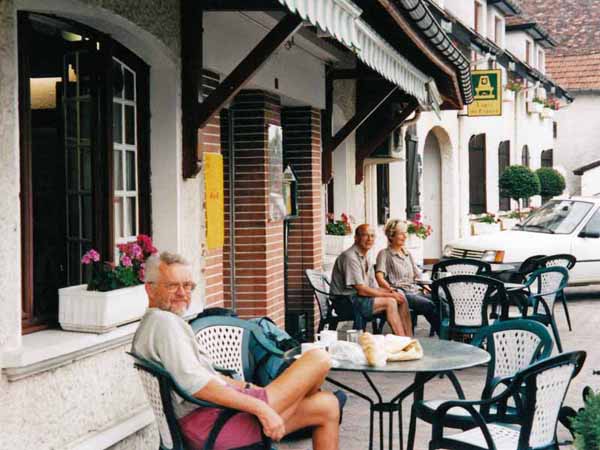
The patter of rain on the tent accompanied the morning clamour of the birds. The idea of an enforced day off had momentary appeal, until we remembered that we were at one of the least interesting towns on the pilgrimage.
The matter was settled as soon as we crawled out, when the rain dwindled to a fine mist.
We left at 7:30, cutting through on farms roads to meet the GR again at the Cami Salié, the age-old road used by traders to bring salt from the mines at Salies-de-Béarn.
The threat of the English losing control of Gascony, with its valuable salt market, was one of the reasons for the start of the Hundred Years’ War in 1337. However, the road is much older than that, and follows a natural contour around the edge of the plateau.
Before long we came to the highway and turned onto a long bridge that crossed the railway line, the river and the autoroute in one graceful swoop. A few fields past that, we entered the village of Maslacq. It was 9:30 and time for our second breakfast. At the substantial old hotel, we ordered coffee before remembering that we had not been to the baker’s for our usual bag of pastries.
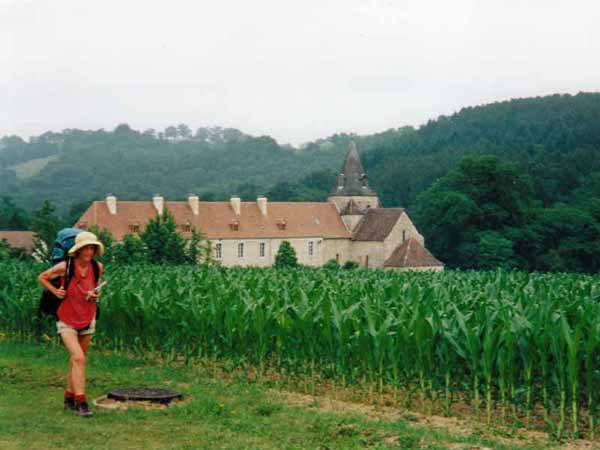
Keith hurried off, following the instructions of the waiter, got lost, but eventually returned with the goods. Meanwhile our Flemish comrades had arrived, a fast-walking couple whom we had seen periodically ever since Saint-Antoine.
He spoke good English, learned from a book, and translated his wife’s utterances from Flemish. They were only going as far as the abbey of Sauvelade, which is why they had not started at their usual 6 am.
Greatly refreshed, we pressed on along the river flats, then sharply up to the crest. Here the traditional direct way to the abbey has been blocked, so walkers have to make a slight detour.
Only the church survives of the large abbey destroyed by the Huguenots in 1569 – a busy year for destruction in this part of the world.
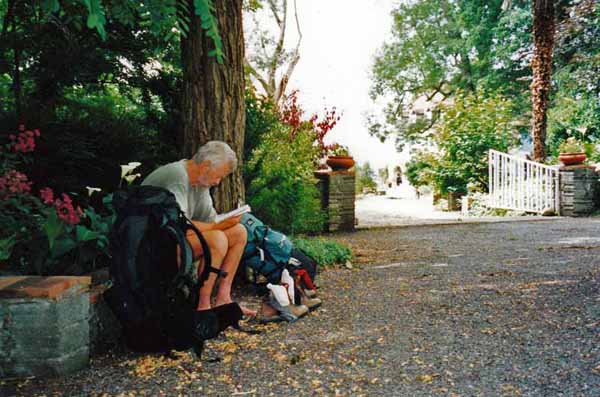
Most of our Alsatian friends were resting on the grass beside the church. Their leader, the little bow-legged, hobbling ex-actor, invited us to free wine at the presbytery at Navarrenx that evening. He had done the pilgrimage before and knew things that we did not.
We entered a region of small hills, surprisingly steep and strenuous in the hot sunshine. It was not tired legs or lack of breath that bothered us, just the heat.
At the top of a rise we sat on a stone bench under a clump of trees for lunch, with various Alsatians tottering past as we ate.
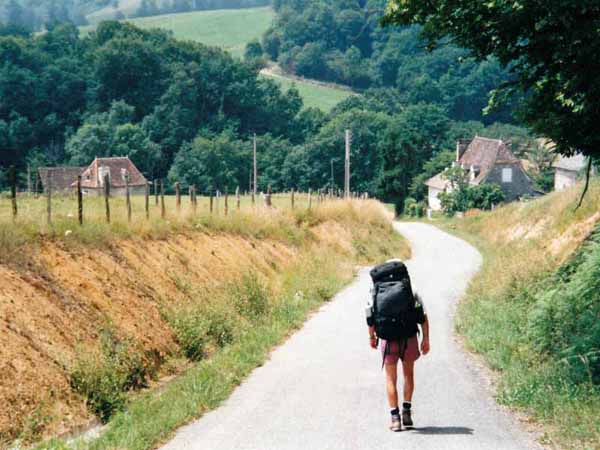
The afternoon walk was similar, ending in a long descent through a forest. As we stood having a swig of water, we saw the Flemish fliers approaching.
They had changed their minds about staying at Sauvelade when they found out that dinner would be bread and water. They are religious, but not that religious.
For the last kilometre into Navarrenx we took the road, which was lined with shady plane trees, rather than the bald GR.
Once inside the black, forbidding walls, we quickly found a bar near the church and, rather unwisely, had beer instead of a soft drink, with the result that we became mildly drunk. We must have been dehydrated in spite of all the water we had swallowed.
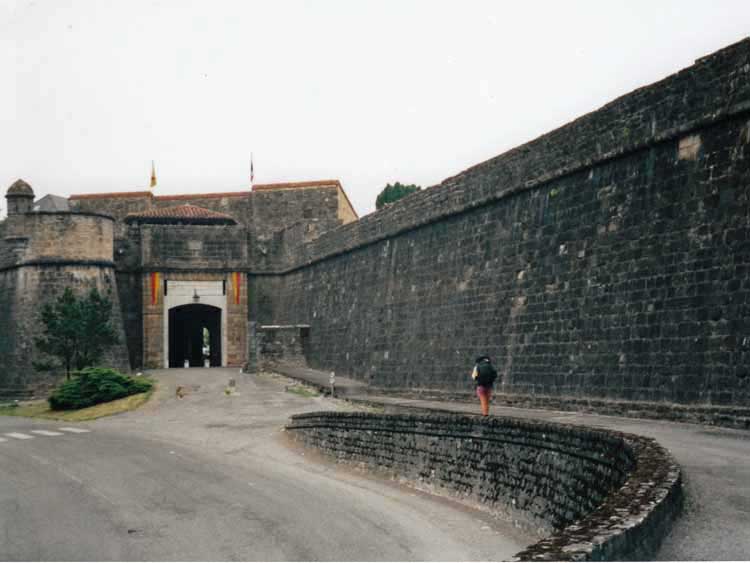
Following the signs, we went back outside the fortifications to the riverside camping ground, had showers and drifted into an alcoholic doze.
Nearby, the grassy moat had been pressed into service for tennis courts, a pleasant change from its original purpose.
We had arranged to meet the Alsatians at 6:30, but we were late because we tried a short-cut through the walls that did not work.
They were just emerging from the church when we got there. We joined the little flock that was being shepherded into a stuffy room for tumblers of sweet, tepid wine.
Then we were welcomed by a beaming man and made to hold hands in a circle to sing the Pilgrims’ Hymn, the chorus of which went “Ultreia! Ultreia! Ultreia! Deo salvator nos”. The man pointed to the words with a long cane as we sang.
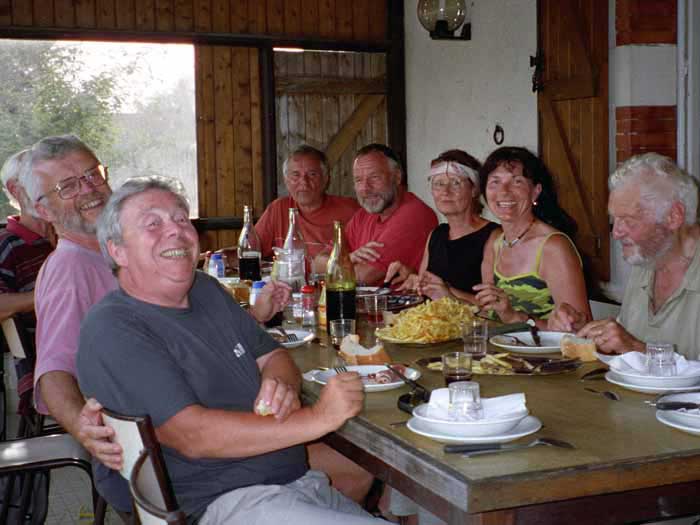
Out in the fresh air, Jean-Marie, the little actor, got on his mobile phone and requested transport for eight hungry pilgrims to some eatery he knew of.
A red van soon arrived and took us to a mangy-looking country swill-shop (Les Platanes), where a long table had been laid.
The other tables were occupied by gnarled, whiskery, possibly illiterate regulars. One of them seemed to have strayed onto our table, but we later found out that he too was a pilgrim.
Our green-complexioned host brought the meal, which consisted of a tasteless garbure, followed by thick, dry slices of ham, then trays of steak that the vet amongst us certified was from a 25-year-old cow, and a mountain of chips.
Dessert was a plastic bucket of icy poles and we drank wine, water and coffee from the same cheap tumblers. Nevertheless we had a delightful evening of laughter and stories.
Previous day: Arzacq-Arraziguet to Arthez-de-Béarn